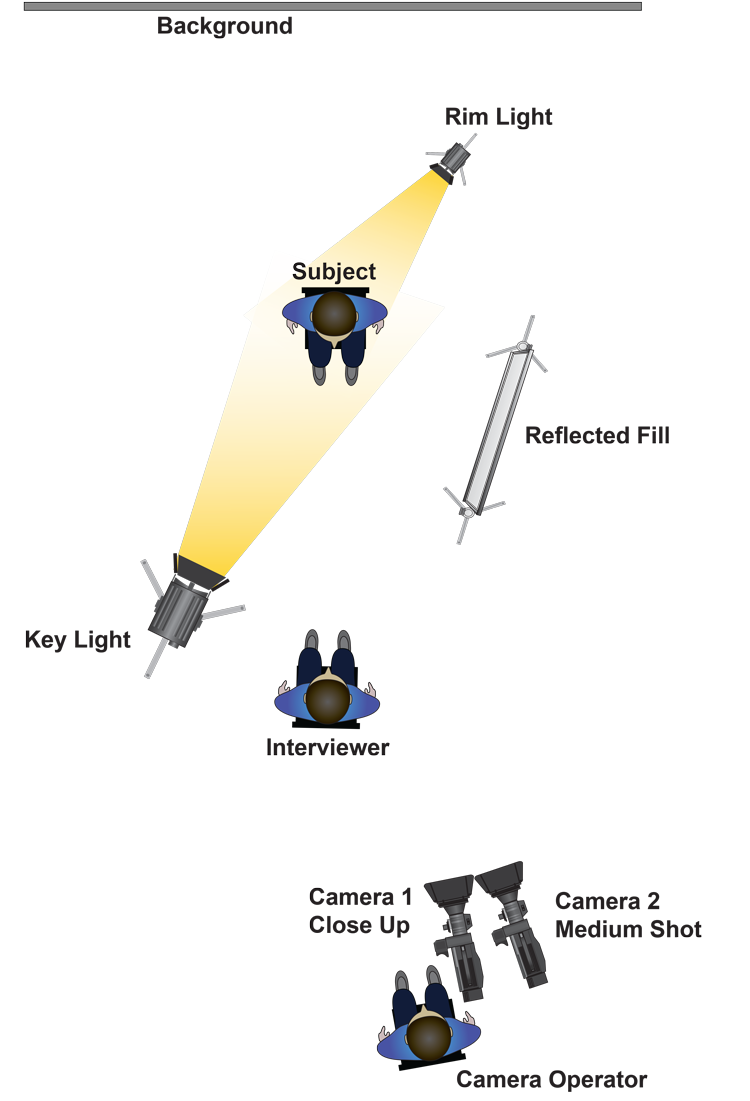Interview Camera Setups
You have many choices as to how to shoot an interview, determined in part by the story, the style of the movie, availability of equipment, size of the crew and the amount of physical space in which to shoot.
Remember, the better the coverage, the more options you'll have in the editing room. Below are the most common ways of shooting sit-down interviews.
Single Camera with Operator
One of the most common interview types requires one camera, a camera operator and an interviewer. In this configuration, the camera operator can ensure the subject remains within the frame, and can reframe during questions to vary the frame size.
One of the benefits of this configuration is that the camera can be positioned behind the interviewer, so it does not distract the subject.
When you use this set-up, there are a number of benefits:
The camera operator can begin recording without the interview subject knowing, allowing the interviewer to ease the subject into the interview.
The camera operator can monitor the audio, so the interviewer doesn't have to wear distracting headphones.
The camera operator can zoom in during emotional or intense moments in the interview.
The camera operator can change the frame size between each answer to give visual variety to the interview.
The camera operator is another set of eyes and can be on the lookout for interesting shots the interviewer may not be aware of.
Single Camera with No Operator
One of the most difficult shooting techniques, this set-up requires the interviewer to also operate the camera. The obvious issue is that the interviewer must split his focus between the subject and the camera, constantly checking framing, audio levels, and the amount of available media. Unfortunately, for many documentarians, this is the only option.
If you need to conduct the interview and operate the camera, follow these guidelines:
Position the camera right next to you so you have easy access to the camera and tripod controls.
Lean as close to the lens as possible to bring your subjects eye line close to the lens.
Consider framing the shot a little wider so you don't have to constantly adjust the frame every time the subject moves.
Consider using a portable field monitor so you can glance at it to check camera settings and framing.
Use one ear of an earbud to monitor the audio without distracting your subject with big bulky headphones,
Always sit between the camera and the key light.
When it's time to start the interview, quietly hit record and don't make a big production about it. The more subtle you are, the more at ease your subject will be.
Always set the audio levels before you begin, but remember that many people tend to get louder throughout the interview. Consider lowering one channel of audio as a backup should the subject get loud.
Dual Camera, Shooting on Axis
For more elaborate sit-down interviews, you may want to use two cameras. In this configuration, both cameras are positioned as close to each other as possible, and placed close to the subject's eye line.
One camera (typically the camera closest to the subject's eye line) is framing a close-up. The camera farther from the eye line frames a medium shot. The shot sizes are different enough so that the editor can seamlessly intercut between the two frames.
There are a number of benefits to this set-up:
The editor will be able to choose from two different frame sizes at any time throughout the interview.
A camera operator does not need to readjust the frame size throughout the interview.
The second camera can be positioned anywhere for a more stylized look.
When using two cameras, it's critical to ensure the settings match between the two cameras. Always check:
Focus
Exposure
White Balance
Gamma Settings
Typically, audio can be run into one camera, with the other camera's onboard microphone providing reference audio. Always ask your subject to clap once at the top of the interview so there is a sync mark to help the editor line-up the two cameras in post.
Two Cameras, Cross Shooting
For more elaborate sit-down interviews in which you need to simultaneously shoot both the subject and the interviewer, you may need to use two cameras. One camera will frame the subject and the other camera, the interviewer.
This is a complete set-up that not only requires two camera, but two operators, and enough lighting to properly light each person.
If you need to use this set-up be aware of the following:
Make sure the space in which you're shooting is large enough to accommodate the camera and lighting set-up.
Make sure the backgrounds in both directions (behind the subject and behind the interviewer) are visually pleasing, and that there is enough set dressing to create a similar look between shots.
Remember that you need two sets of three-point lighting - both the subject and the interviewer each need his own key light, fill light and rim light. Lighting this set-up is more complicated because you need to ensure the spill from one person's lighting doesn't affect the other person's light.
The cameras need to positioned close enough to each person's eye line without being in the other camera's shot.
There must be ample space for the other crew members - typically sound, hair/make-up and a producer.





